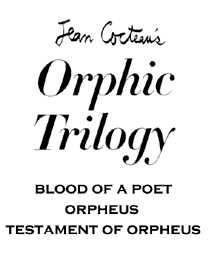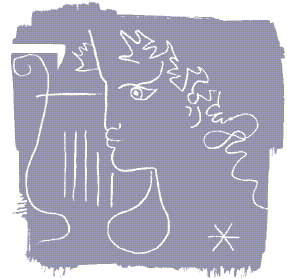  |
|
A Black Silence Almost as Violent as Laughter: Jean Cocteau (1889-1963) has been called the most versatile artist of the twentieth century, and in this case hyperbole has at least some basis in reality. Born to a middle-class family in Paris, he excelled from youth in an almost absurd range of fields: filmmaking, poetry, graphic art, fiction, drama, couture, even postage-stamp design. Most of all, Cocteau was a brilliant, witty, self-invented personality whose talents put him at the forefront of practically every "ism" of the century, from surrealism to modernism to Dadaism. The persistence of fairy tale, mythological, and other classical motifs in his work adds a gravitas — a word Cocteau would no doubt bristle at, as being much too serious — that makes it arguably unique in modern art.
While it’s hard at this point to judge the breadth of his achievement — much of his work outside cinema is difficult to find — his films have been consistently available as staples of the arthouse circuit, cine clubs, and classrooms devoted to the aesthetics of cinema. Cocteau was not prolific in this area: he made only six films over a three-decade period. Of these, four — Beauty and the Beast and the "Orphic trilogy" — stand almost sui generis as representatives of the poetic consciousness in cinema. The Criterion Collection’s recent release of the Orphic trilogy in a DVD boxed set affords a welcome chance to reassess these works that were a crucial part of many cinephiles’ introduction to the art of film. All three benefit from crisp digital transfers, restored sound, and new English subtitle translations.
Cocteau’s immersion in surrealism accounts for both the pleasures and drawbacks of the film. Like another surrealist classic, L’Age d’or, The Blood of a Poet was financed by a familiar patron in that world, the Vicomte de Noailles. Both films are concerned with dream states, mysterious autobiography, the martyrdom of artists, and startling visual nonsequiturs. Cocteau’s search for his muse is at its most explicit here, with American surrealist Lee Miller portraying a statue that comes to life to open the way to a dreamy netherworld. Divided into four parts with titles such as "The Wounded Hand, or the Scars of a Poet" and "Do Walls Have Ears?", Cocteau attempts what few would dare: the visualization of an interior space, namely, the poet’s mind. Thus bizarre imagery abounds, from the artist (Enrique Rivero standing in for Cocteau) passing through a mirror, to a talking mouth that appears on his hand, to a wealthy couple inexplicably playing cards on a snowy street while a dead boy lies at their feet. Droll intertitles enliven the film’s slow, stately pace ("The desperate hermaphrodite’s meetings took place in room 23"), and fans of gay subtext will be intrigued by Rivero’s shirtless, hypermasculine image: poet as hunk. Cocteau deserves credit for the cleverness of his special effects (statues coming to life, a little girl levitating), and for the tension between the film’s sophisticated script and images and its often primitive visuals. And, to his credit, the constant charge of frivolousness against Cocteau may not be entirely accurate even in this, his most self-absorbed film. Some critics have connected Blood's images to events in his life; e.g., Cocteau’s father’s suicide is arguably reprised here in the form of the dead child. A different kind of resonance can be found in what could be construed as his subtle attack on his patrons in the image of the wealthy couple mindlessly playing cards in the snow.
Despite such complexities, and the freshness of much of Cocteau’s imagery, The Blood of a Poet is ultimately something of a period piece, more a fascinating curio redolent of the era of such "shocking" bad boys as Dali, Bunuel, and Andre Breton than a convincing, coherent work of art.
Death for Cocteau is not a purely negative force but a rich well of inspiration, and Orpheé must enter that world in order to transcend his material success and relocate his lost muse. Death is also a tragic figure as embodied by the Princess, a bitter romantic who is herself oppressed. Seemingly omnipotent, able to walk through mirrors and kill with a glance, she’s in fact controlled by a frightening cabal of wizened white men who comprise a kind of underworld committee that tracks her compliance with their orders and rigorously punishes any deviations. The Princess’s hints at the kinds of punishments that await her for refusing to carry out their orders add a frisson of horror that filigrees the film.
Cocteau brilliantly visualizes this underworld that controls the life above it. The portal to that world is, as in the earlier film, a mirror that thoughtfully allows the characters to pass through it on their way out of the "real" world. (Cocteau used a vat of mercury to make it seem that Orpheé’s hand was passing through glass.) Nicholas Hayer’s camera glides gracefully through a chiaroscuro world of dark chambers, crumbling edifices, and decaying paths that the film explicitly links to the lost hopes of humanity: "Here are men’s memories, and the ruins of their beliefs."
Much of the film’s seductiveness rests with the characters: Jean Marais (better known as the Beast of Cocteau’s 1946 film) as Orpheé, the glorious Maria Casarès (familiar as the scorned woman who exacts revenge in Bresson’s Les Dames du Bois de Boulogne) as tormented Death, and François Périer as the reluctant chauffeur whose search for an unattainable ideal, even after death, has a tragic intensity. Criterion’s sharp transfer does justice to Cocteau’s superb mise-en-scene, and it’s fleshed out with a 1950 essay on the film by its maker.
Cocteau, then 70 years old, plays a character more or less based on himself, a slightly buffoonish poet who refuses to disappear. His self-reflexivity is in full flower here, as he meets the characters from Orpheus, along with assorted gods and goddesses, historical figures, and mythic creatures (including a centaur). Among those he encounters is his own fictional creation Cegeste, who gives him a flower that he attempts to draw (of course, in a fit of comic hubris, he renders it as an image of himself). After this, he is killed by a goddess, then magically resurrected to continue his journey through time and space.
Cocteau populates this engaging fictional world with many of his friends, lovers, and peers, including his longtime partner Jean Marais, his adopted son Edouard Dhermitte (Cegeste), Yul Brynner, Pablo Picasso, and others. The effect on viewers aware of these connections makes the work striking indeed, another example of the filmmaker’s singular skill in interweaving reality and fantasy long before such generic hybrids as the "docudrama" gained currency.
Testament of Orpheus answers some of the questions posed by Orpheus. The fates of the Princess and Heurtebise, for example, are resolved when they appear as part of an underworld tribunal that puts Cocteau on trial for the crime of "repeatedly attempting to trespass into another world." His comic martyrdom permeates the film; in one scene he demands his own murder, only to reappear in a puff of smoke. If such conceits sound foolish on paper, they play with a kind of sweet urgency onscreen.
Cocteau is at his aphoristic best in Testament of Orpheus. While the film lacks the intensity of its predecessor, it compensates with a stream of witty summings-up, not surprising considering this was his final, and in some ways most forthcoming work: "What can be proven is worthless… Poets only pretend to die… The body containing us does not know us." The richness of such phrases is mirrored in the mise-en-scene, which effortlessly shifts the viewer through a series of enchanting otherworlds. Cocteau once said of what he wants from an audience: "I expect a black silence that is almost as violent as laughter." He wrote this in 1932 about The Blood of a Poet (specifically about the "tragic gag" some say he invented), but the phrase applies equally to the entire Orphic trilogy. Cocteau’s masterful survey of interior worlds and his graceful shifts from wonder to terror to humor makes each of the three films here estimable in its own right, transcendent en masse.
Jean Cocteau's "Orphic Trilogy" is now available on DVD from The Criterion Collection. This three-disc box set includes The Blood of a Poet, Orpheus, and Testament of Orpheus. All three DVDs feature new digital transfers with restored image and sound (as well as new English subtitle translations). These DVDs are filled with extras. Disc One: The Blood of a Poet includes a collection of rare behind the scenes photos; Edgardo Cozarinsky's renowned 66-minute 1983 documentary Jean Cocteau: Autoportrait d'un Inconnu (Autobiography of an Unknown); a transcript of Cocteau's lecture given at a 1932 screening of The Blood of a Poet and a 1946 essay on the film by Cocteau. Disc Two: Orpheus includes Cocteau's essays on Orpheus from 1950. And Disc Three: Testament of Orpheus includes Villa Santo Sospir, a 16mm color film by Cocteau featuring many of the locations used in Testament of Orpheus and a collection of Cocteau's writings on Testament of Orpheus. Suggested retail price: $79.95. For more information, check out the Criterion Collection Web site.
|





